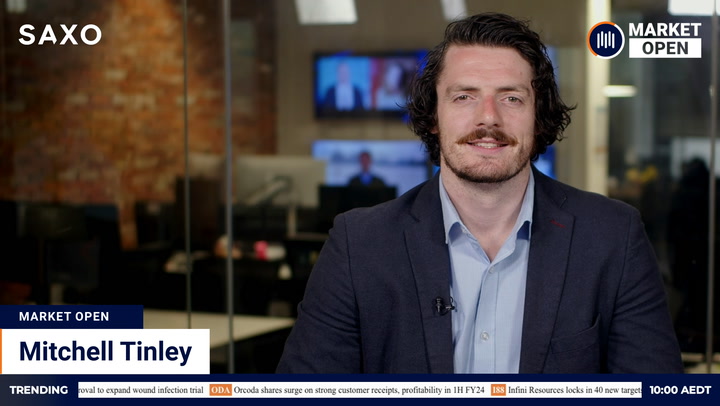The long weekend stock rout looked set to continue into a third session after fears of a global economic slowdown fuelled another night of heavy overseas selling.
ASX futures plunged 107 points or 1.47 per cent as Wall Street’s main indices closed at session lows. The S&P/ASX 200 has already fallen more than 270 points across the holiday.
The Nasdaq Composite shed almost 4 per cent, sending the index deep into bear market territory. The S&P 500 fell 2.8 per cent to a six-week low. European stocks also declined.
Commodities rebounded as China pledged support for its economy while it struggles to contain a Covid outbreak. Iron ore, crude and most metals rallied.
Wall Street
US stocks fell heavily for the third time in four sessions amid fears rising interest rates and a Covid outbreak in China threaten global growth. Big Tech spearheaded the selling as sceptical investors dumped companies ahead of quarterly earning updates.
The Nasdaq Composite dived 514 points or 3.95 per cent to its lowest close since 2020. The S&P 500 lost 121 points or 2.81 per cent. The Dow Jones Industrial Average gave up 809 points or 2.38 per cent.
Rate-sensitive growth stocks led declines. Netflix sagged 5.48 per cent to a five-year low. Tesla, which builds cars in Shanghai, tanked 12.18 per cent. Nivdia lost 5.6 per cent.
“There’s a lot of anxiety ahead of the earnings which are coming up Tuesday, Wednesday and Thursday just because if they don’t hold up, then there’s nothing left to hold up the market,” Thomas Hayes, chairman of Great Hill Capital, told Reuters.
Microsoft and Google parent company Alphabet both lost more than 3 per cent in regular trade, before trading mixed in after-market trade after releasing earnings. Alphabet plunged another 5.1 per cent in extended trade this morning. Microsoft was lately up 1 per cent.
“The risk-reward is just not there into big-cap tech earnings,” Satori Fund senior portfolio manager Dan Niles told CNBC. “I expect every single one of them to see forward numbers go down.”
Wall Street’s “fear gauge”, the VIX, jumped 24 per cent to a six-week high. The Russell 2000 index of small caps dropped 3.26 per cent to its lowest since November 2020.
Companies meeting profit expectations were punished for weak outlooks. GE slid 10.34 per cent, UPS 3.48 per cent, 3M 2.95 per cent and PepsiCo 0.25 per cent.
Earlier, Europe’s pan-European Stoxx 600 fell 0.9 per cent in the wake of further selling in China. The Shanghai Composite added to Monday’s 5.1 per cent dive with a loss of 1.44 per cent yesterday.
Australian outlook
Look out below. Monday’s tentative Wall Street rebound now looks like a blip in an accelerating downtrend. The S&P 500 finished right at technical support provided by last month’s plunge. If that fails, this market could go a lot lower.
The S&P/ASX 200 has given up 3.6 per cent in two sessions and appears likely to extend that figure to around 5 per cent today unless quarterly inflation data at 11.30 am AEST spring a surprise.
The ABS’s Consumer Price Index is widely expected to confirm the case for higher rates, so a weak result may soothe investor jitters. Alternatively, a “hot” result would likely add to selling pressure. The market consensus is for a 1.7 per cent increase in the index.
“It was another drubbing for the ASX 200 yesterday with all sectors in the red and 80.5% of its stocks declining. And whilst it was only its fifth worst day of the year, it was enough to see the index trade back beneath this year’s opening price to add insult to injury,” City Index senior market analyst Matt Simpson said.
“7300 is the next obvious level for bears to conquer, and a strong inflation report today could be just the trigger for a firm close beneath it.”
The dollar continued to wilt under a typical flight to the perceived security of the US dollar. The Aussie dropped 0.72 per cent to 71.25 US cents.
A tentative overnight recovery in hard commodity prices could provide a cushion this session, but appeared to do little for US miners. The US materials sector shed 1.55 per cent. BHP and Rio Tinto bounced in London trade, then faded in US action.
BHP‘s US-traded depositary receipts fell 2.5 per cent following a 1.72 per cent rebound in UK trade. Rio Tinto lost 2.96 per cent in the US after gaining 1.51 per cent in the UK.
Energy was the only US sector to finish higher, up a slender 0.05 per cent. The three sectors dominated by ‘Big Tech’ lost at least 3.1 per cent. Financials also suffered a bruising night, falling 2.55 per cent.
The domestic Q3 reporting season rolls on this session. There are no more initial public listings scheduled until Friday.
Commodities
Commodity markets steadied as China scrambled to contain a Covid outbreak and assuage the economic impact of lockdowns. Authorities closed down one district of Beijing while testing continued in other parts of the capital.
The central financial committee pledged to increase spending on infrastructure to stimulate the economy. The People’s Bank of China said it would offer support for small businesses.
“Policy may be the salvation for China’s iron ore and base metal demand this year,” Vivek Dhar, CBA commodities analyst, wrote.
The spot price for iron ore landed in China bounced 66 US cents or 0.4 per cent to US$150.39 a tonne.
Benchmark copper on the London Metal Exchange rose 0.8 per cent to US$9,863 a tonne. Nickel firmed 1.4 per cent, zinc 0.4 per cent and tin 1.8 per cent. Aluminium lost 0.8 per cent and lead 0.3 per cent.
US oil climbed back above US$100 a barrel. West Texas Intermediate for June delivery rose US$3.16 or 3.2 per cent to US$101.70. Brent crude settled US$2.67 or 2.6 per cent ahead at US$104.99 a barrel.
“Oil prices rebounded big time after the Chinese government failed to impose a lockdown on Beijing and promised more stimulus for people impacted by previous shutdowns,” Phil Flynn, analyst at Price Futures Group, said.
“More stimulus from China could mean more oil demand and that is a sign of hope in a market that has been concerned about slowing demand not only in China but around the world.”
Gold climbed off its weakest level since February. Metal for June delivery settled US$8.10 or 0.4 per cent higher at US$1,904.10 an ounce. The NYSE Arca Gold Bugs Index declined 2.31 per cent.





